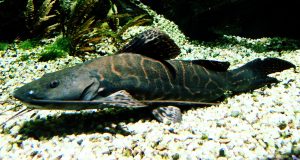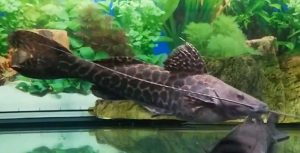Leopard Catfish (Perrunichthys perruno) also known to tropical fish keeping enthusiasts as Perruno Catfish or Reticulated Pimelodid are native to Colombia and Venezuela, where they occurs in the Lake Maracaibo basin and Rio Negro system. It is the only catfish species in the order Siluriformes of the monotypic genus Perrunichthys.
Juvenile Leopard Catfish are occasionally acquired by tropical fish keeping enthusiasts but because of their large size, over 23.6 inches, they require a large tank to thrive in captivity.
Leopard Catfish are a predatory, long whiskered species that are sometimes confused with the Sailfin Pimelodid (Leiarius pictus) and the Marble Antenna Catfish (Leiarius marmoratus)
Perrunichthys perruno have an elongated body with large deeply forked caudal fin, a depressed head, a broad snout, and a wide mouth. The upper jaw is slightly longer than the lower jaw. They have two pairs of shorter mandibular barbels and long maxillary barbels that in adult specimens can extend almost to the caudal fin.
Leopard Catfish have a dark chocolate brown body with lighter colored reticulated markings over the body and fins. Their long barbels, dorsal, and paired fins are colored the same as the body but in some fish, the fins have spotted instead of reticulated markings. Adult males are more slender than females, especially during the breeding season.
In their natural habitat, Leopard Catfish feed on fish, worms, crustaceans, and almost anything they can fit into their large mouth. They are highly predatory and can fast for extended periods of time after consuming a large meal.
In an aquarium environment, they are best kept in a single species tank. If housed in a community environment, they should never be kept with smaller fish species. Good possible tankmates are Oscars, large characins, Pseudodoras niger, Osydoras niger, Pterdodoras granulosus, or Megalodoras uranoscopus.
Leopard Catfish are best kept in a planted aquarium of at least 150 gallon capacity with a fine gravel, sand, or mixed gravel/sand substrate, a few large river rocks, several large pieces of driftwood
or bogwood, and some large background plants. A few floating plants
can also be added for shade.
Perrunichtys perruno are intolerant of poor water conditions and should be provided with an oversize filtration system and weekly 25% water changes to maintain the water quality necessary for their well being. A power head is also recommended to provide some current in the tank.
To date there have been no successful breeding of Perrunichthys perruno in an aquarium environment.
Leopard Catfish are carnivores that in their natural habitat predominately prey on smaller fish, river crab, crayfish, worms, etc. In an aquarium environment, they can be fed pieces of fresh dead fish, crayfish, mussels, prawn, earthworms, and even over time commercial sinking catfish pellets
.
Leopard Catfish (Perrunichthys perruno) are usually not available to tropical fish keeping enthusiasts from fish stores except by special order or when brought in with mixed shipments, if at all. They are occasionally sold online directly from importers and through wholesale facilities in various sizes.
Minimum Tank Size: 150 gallons
Care Level: Moderate
Temperament: Predatory
Aquarium Hardiness: Hardy
Water Conditions: 72-79°F , >18ºdGH, pH 6.0-7.2
Max. Size: 24″
Color Form: Brown, Tan
Diet: Carnivore
Compatibility: Keep with larger fish
Origin: Colombia, Venezuela
Family: Pimelodidae
Lifespan: 20 years
Aquarist Experience Level: Advanced





